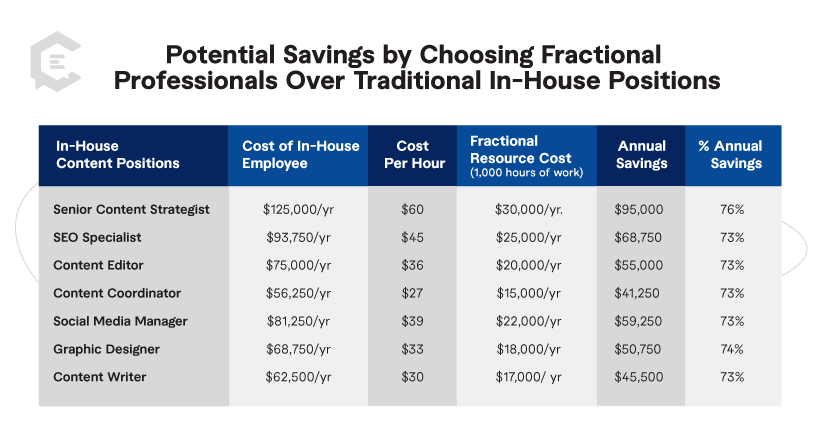In marketing, as in most businesses overall, efficiency isn’t just a buzzword — it’s a survival strategy.
The traditional marketing playbook, including in content — relying heavily on fixed full-time roles and ever-growing budgets — doesn’t align with the demands of the modern market. Today, every dollar counts, and agility is essential. Sticking to outdated methods means risking not just inefficiencies but also the very relevance of your marketing efforts.
In thousands of conversations with potential content services buyers over the past decade, I’ve heard many different issues, from low-quality content due to low-quality writing talent to frustration over time spent doing content revisions to underperforming content due to a myriad of interconnected factors.
They all boil down to one thing — an old approach to talent resourcing that doesn’t align with the needs of a modern and flexible marketing operation. Our marketing team at ClearVoice experiences the same pains and now blends in-house expertise with fractional talent, significantly cutting costs while boosting the ability to innovate and adapt swiftly. Not to mention, our marketing team has saved nearly 38 percent of operating expenses in the process.
Let’s explore how we can transform your content marketing team to enhance productivity and drive significant strategic impact.
Pitfalls of Old Content Marketing Models
Is this you? You’re stuck in a full-time employment model, locked into rigid staffing structures that don’t align with fluctuating needs.
For instance, you might have a highly paid senior marketer rewriting blog headlines or a junior team member trying to strategize a major campaign out of their depth. This mismatch in resource allocation leads to significant inefficiencies, ramping up costs and dampening creativity, not to mention the likely impossibility of maximizing results potential.
Imagine this: a lean, dynamic marketing team, brimming with talent, tasked with pushing the boundaries of creativity and strategic impact. Sounds ideal, right?
Seriously, consider the inefficiency of a senior content leader, who is paid $100K annually and performs tasks that an entry-level coordinator, who is paid $45K, should be doing. There’s clearly a disconnect. This misallocation of resources leads to significant financial waste and job dissatisfaction.
For example, shifting to a managed team model employing fractional talent can save businesses significantly by aligning expenses directly with project needs and reducing wasted labor hours. This strategic realignment not only optimizes costs but also amplifies creative and strategic output.
Just imagine your marketing team not getting bogged down by the daily grind but empowered to push creative boundaries and strategic impacts. Yet, reality often sees them stuck in low-impact tasks, leading to frustration and burnout. The lack of clear career advancement — highlighted by a 2022 Pew Research Center survey in which 23 percent of American workers expressed dissatisfaction with growth opportunities — exemplifies the flaws in traditional employment models.
Aligning Resources with Business and Marketing Goals
There are many ways to win in marketing — driving revenue and audience growth, of course. But mastering efficiency also brings value to the business.
Fractional employment is a strategic solution to this need, allowing companies to engage seasoned professionals on a part-time basis. This flexible approach caters perfectly to the diverse and dynamic demands of modern marketing, ensuring that each initiative is tightly aligned with broader business objectives and contributes directly to the bottom line.
Fractional hiring allows for the precise targeting of gaps within your marketing apparatus, providing the expertise needed without the long-term commitment associated with full-time hires. This method is particularly effective in managing budget constraints while still accessing top-tier talent for specific projects or during peak demand periods.
At ClearVoice, we’ve designed our services to support this adaptable approach. Whether you’re reassessing your current team’s capabilities or looking to integrate new skills, our solutions offer a range of options to ensure your marketing efforts are as efficient as they are effective.
Here’s how we help you align your resources with your business goals:
Assessing Team Capabilities and Needs
Before you introduce fractional hires, it’s vital to evaluate your current team’s structure. Do this with the following in mind:
- Evaluate your marketing goals: Review short-term and long-term marketing objectives. What skills are necessary to achieve these goals? Are there any skills gaps on your current team? Could team members be used more effectively?
- Assess the scope of work: Look for areas that need improvement or require specialized skills that your team lacks. This could be anything from SEO, content marketing, or data analytics. Take note that these have to be project-based or don’t require full-time commitment.
- Dream big: Take a big-picture look at your upcoming marketing goals. What strategies would you implement if you had more time or resources? How far do you want to scale production?
By evaluating your current team structure with this in mind and answering all questions, you can begin to properly allocate the correct resources where needed with grounded evidence.
Strategic Resource Allocation
Our team at ClearVoice can aid in this evaluation by providing insights into your team’s makeup and identifying potential areas for enhancement. Understanding the scope of work required for upcoming projects is a necessity. This analysis helps ensure that the tasks are project-based and do not require a full-time commitment, allowing for more strategic resource allocation.
When planning to incorporate fractional talent, consider the following:
- Staffing Gaps: Identify the unfilled roles or functions and the ideal timing for bringing in the right talent.
- Project-Based Needs: Pinpoint specific projects that could benefit from niche expertise.
- Strategic Initiatives: Assess whether you need temporary help to manage long-term strategies or fulfill crucial functions supporting your current strategies.
Utilizing fractional talent through ClearVoice offers a strategic solution to create high-quality content while significantly reducing annual labor costs. Here’s a breakdown of potential savings when choosing fractional professionals over traditional in-house positions:
These numbers illustrate the cost savings and efficiency gains from fractional talent, with hourly rates calculated based on an assumed 1,000 hours of part-time work per year. Adopting a fractional model can not only enhance your content marketing capabilities but also align with financial prudence, allowing for an average savings of more than 73 percent compared to traditional employment costs.
Integrating Fractional Talent
Incorporating fractional content pros into your existing organization can significantly enhance your operational flexibility. Our solutions allow you to scale up or down based on your current needs. Each option is designed to integrate seamlessly with your ongoing operations, whether you need consistent content flow or an agile response to a shifting market.
- ClearVoice Managed: Ideal for businesses seeking regular, high-quality content. This plan provides a steady stream of material managed by experienced creators.
- ClearVoice Flex: Enhances your team with fractional resources that adjust to your needs, helping you manage month-to-month variations in content demand or specific project requirements.
- ClearVoice DIY: Provides access to the ClearVoice Talent Network and workflow features to manage the content production process yourself from beginning to end in our content platform.
By adopting a fractional employment model, businesses can optimize their content strategies to be more responsive and cost-effective, ensuring that their marketing aligns perfectly with their strategic business goals. This approach not only saves costs but also drives innovation and adaptability across all levels of content creation and marketing strategy.
Transitioning to a Flexible Marketing Apparatus
Switching to a hybrid or entirely fractional team structure may seem complex, but we’re here to tell you — it’s not. Here’s our guide to making this transition smooth and effective:
-
Assessment and Planning:
- Evaluate Your Current Team: Assess your team’s strengths and identify any skill gaps. Understand which tasks are overextending your team or could benefit from specialized skills.
- Define Needs and Objectives: Specify your expectations for fractional hires, such as content creation, SEO optimization, or data analytics. Set clear objectives, deadlines, and deliverables to align these roles with your overall marketing goals.
-
Hiring and Onboarding:
- Recruitment: Leverage platforms like ClearVoice to access a pool of vetted fractional talent that aligns with your team’s culture and expertise.
- Virtual Interviews: Conduct interviews to ensure candidates are well-aligned with your brand’s vision and can integrate smoothly into your operations.
- Streamlined Onboarding: Tailor the onboarding process for fractional employees, including detailed job descriptions or expectations and introductions to current projects and workflows.
-
Integration and Communication:
- Establish Communication Protocols: Set communication frequencies and methods, such as daily stand-ups or weekly updates, to keep everyone informed and engaged. This should occur in the forum your teams usually communicate in (i.e., Slack, email, Zoom).
- Use Project Management Tools: Implement tools like Asana, Monday.com, or Trello to maintain task organization and transparency, keeping in-house and fractional teams aligned.
- Knowledge Sharing: Develop a digital repository for all team members to access essential resources, facilitating quicker onboarding for fractional workers.
- Buddy System: Pair fractional employees with experienced staff to aid integration and provide support, enhancing productivity during the adjustment phase.
-
Management and Evaluation:
- Set Clear Expectations and KPIs: Clearly define the roles, responsibilities, and performance metrics for fractional hires to ensure alignment with strategic goals.
- Regular Feedback and Adjustments: Foster a feedback-rich environment and make necessary adjustments to optimize the integration process and encourage continuous improvement.
By meticulously planning each phase of the transition to a fractional model, you can maximize the benefits of flexibility and specialized expertise without the overhead associated with full-time hires. At ClearVoice, we facilitate this transition by providing access to skilled professionals and managing the workflow to ensure your content strategy thrives in a dynamic marketing environment.
Maximize Your Efficiency With Fractional Teams
Fractional hires allow you to bring in experts to execute specific tasks and campaigns. With a fractional team, you’re able to be more agile, more experienced, and more efficient than an in-house team. At ClearVoice, we’re passionate about it because we know it works.
If you’re unsure how a fractional team could help your marketing department, talk to a content strategist to learn how blending in-house and fractional workers could help supercharge your goals.









